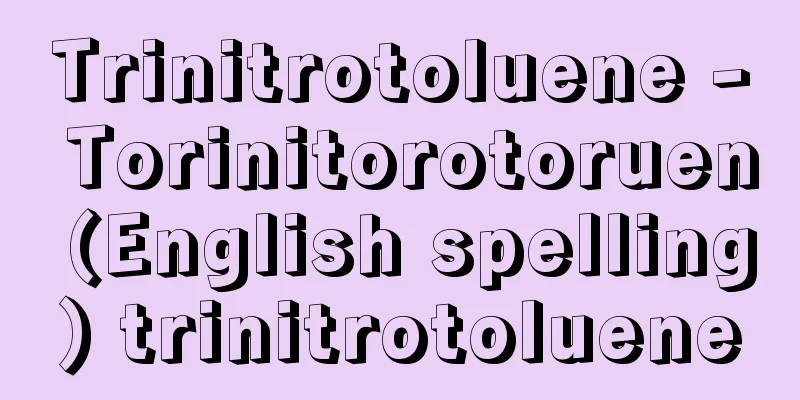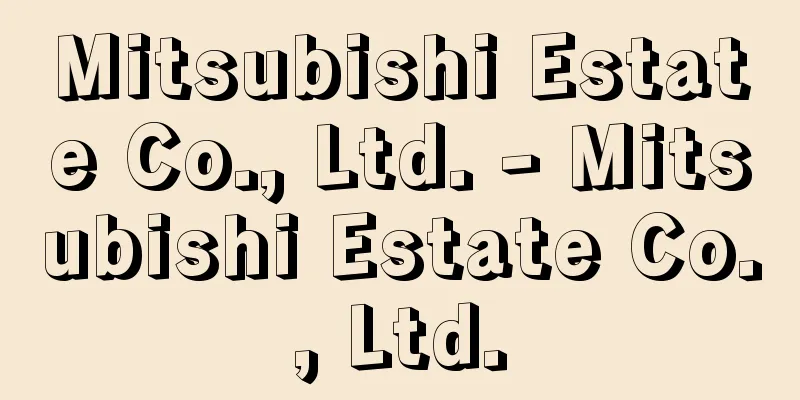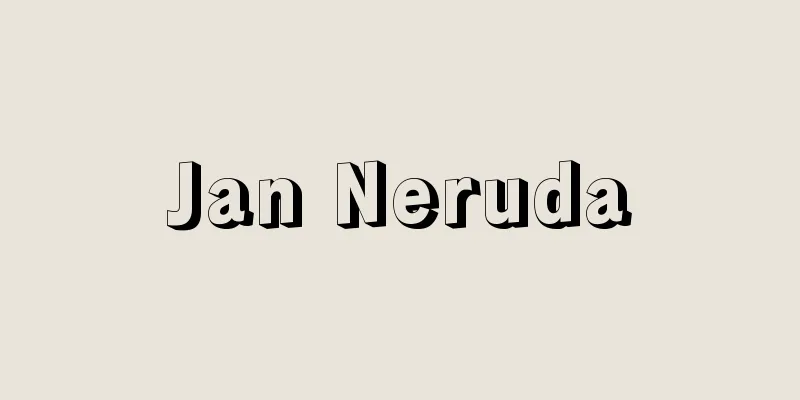Trinitrotoluene - Torinitorotoruen (English spelling) trinitrotoluene

|
A high-performance military explosive known as TNT. In Japan, it was also called trotyl or chakayaku. TNT was created in 1863 by Julius Wilbrand (1839-1906) of Germany. Until the 1920s, picric acid (Shimose powder) was the main military explosive, but because it had some drawbacks, it was used in combination with TNT, which did not have those drawbacks. TNT, used as an explosive, is 2,4,6-trinitrotoluene, which is used after separating and purifying other isomers. It is a pale yellow crystal. Its ignition point is 475°C, which decreases when alkali is added. It is not hygroscopic, insoluble in water, and soluble in concentrated sulfuric acid, concentrated nitric acid, and many organic solvents. In differential thermal analysis, its decomposition temperature is 250°C, and its explosion velocity is 6,900 meters per second with a specific gravity of 1.6. It is relatively insensitive to friction and impact, and has good stability. Unlike picric acid, it does not react with heavy metals to produce metal salts that are very sensitive to friction and impact. Its low melting point of 80.8 °C makes it easy to melt and fill artillery shells, and it has been the most widely used explosive. It can be used alone or mixed with other explosives. Examples of binary TNT explosives include Pentolite (mixture with PETN), Cyclotol (mixture with hexogen = RDX), Amatol (mixture with ammonium nitrate), Octol (mixture with octogen = HMX), and Tritonal (mixture with aluminum). Composition B, consisting of 60% RDX, 40% TNT, and a small amount of wax, was also one of the explosives used in large quantities during World War II. Another feature of TNT is that it is relatively easy to manufacture. It is manufactured through a three-stage nitration reaction using toluene and nitric acid as raw materials, and concentrated sulfuric acid and oleum as secondary materials. [Tadao Yoshida and Shingo Date] [References] | | | [Supplementary Materials] |©Shogakukan "> The manufacturing process of trinitrotoluene (TNT) Source: Shogakukan Encyclopedia Nipponica About Encyclopedia Nipponica Information | Legend |
|
TNTの別名で知られる高性能軍用爆薬。日本ではトロチル、茶褐薬などともよばれた。TNTは1863年ドイツのウィルブラントJulius Wilbrand(1839―1906)によってつくられた。1920年代まではピクリン酸(下瀬(しもせ)火薬)が主要軍用爆薬として存在したが、いくつかの欠点をもつために、それらの欠点のないTNTと併用された。 炸薬(さくやく)として使われるTNTは、2,4,6-トリニトロトルエンで、他の異性体を分離精製して用いられる。淡黄色の結晶。発火点は475℃、アルカリが加わると低くなる。吸湿性はなく、水に不溶で、濃硫酸、濃硝酸および多くの有機溶媒に溶ける。示差熱分析における分解温度は250℃、爆速は比重1.6で毎秒6900メートルである。摩擦および打撃に対しては比較的鈍感で、安定性もよい。ピクリン酸と異なり、重金属と反応して摩擦、打撃に非常に敏感な金属塩をつくることもない。 融点が80.8℃と低いので、砲弾などに溶填(ようてん)することが容易で、炸薬としてもっとも多く使われてきた。単独でも使われるが、他の爆薬と混合しても用いられる。二成分含TNT爆薬の例としてはペントライト(PETNとの混合物)、シクロトール(ヘキソーゲン=RDXとの混合物)、アマトール(硝安との混合物)、オクトール(オクトーゲン=HMXとの混合物)、トリトナール(アルミニウムとの混合物)などがある。RDX60%、TNT40%および少量のワックスからなるコンポジションBも第二次世界大戦中に大量に使われた炸薬の一つである。 製造が比較的容易なこともTNTの一つの特長である。トルエンと硝酸を原料とし、濃硫酸および発煙硫酸を副原料として3段階のニトロ化反応を経て製造される。 [吉田忠雄・伊達新吾] [参照項目] | | | [補完資料] |©Shogakukan"> トリニトロトルエン(TNT)の製法 出典 小学館 日本大百科全書(ニッポニカ)日本大百科全書(ニッポニカ)について 情報 | 凡例 |
<<: Trinil - Trinil (English spelling)
Recommend
Chilōn (English spelling)
…He is credited with writing maxims such as "...
American Quilting
…English quilting is when two pieces of fabric ar...
Chalcosoma caucasus (English spelling) Chalcosomacaucasus
… [Chokane Hayashi]. … *Some of the terminology t...
Vermilion Bird
The Japanese era name (nengo). It was the era name...
Oki's Dog - Oki's Dog
...In the "Illustrated Guide to Famous Produ...
Oonamuchi-no-Mikoto
...In particular, there are many articles about t...
Stubborn itching -
A skin disease caused by infection with various ty...
Ando Kou
Year of death: April 8, 1963 Year of birth: Decemb...
Chinju no Mori - Shrine Forest
The grove surrounding a shrine dedicated to the gu...
Kunio Maekawa
Architect. Born in Niigata City. Graduated from t...
Fushikaden - Fushikaden
This is a treatise on Noh by Zeami, the master of...
false ipecac (English spelling) falseipecac
... In addition to ipecac, other plants that are ...
Tataki (Japanese clay) - Tataki
A dirt floor finished with tataki-do (pounded ear...
lobeline
...It is distributed throughout Japan and widely ...
Cacajao melanocephalus (English spelling) Cacajaomelanocephalus
… [Kuroda Suehisa]. . . *Some of the terminology ...









